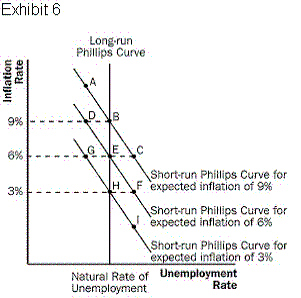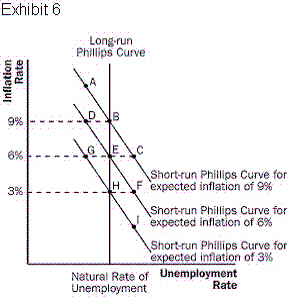True/False
Indicate whether the
statement is true or false.
|
|
|
1.
|
The Phillips curve illustrates the positive relationship between inflation and
unemployment.
|
|
|
2.
|
If inflation is 4 per cent and unemployment is 6 per cent, the misery index is 2
per cent.
|
|
|
3.
|
In the short run, an increase in aggregate demand increases prices and output,
and decreases unemployment.
|
|
|
4.
|
When unemployment is below the natural rate the labour market is unusually
tight, putting pressure on wages and prices to rise.
|
|
|
5.
|
An increase in price expectations shifts the Phillips curve upward and makes the
inflation unemployment trade-off less favourable.
|
|
|
6.
|
An increase in the money supply increases inflation and permanently decreases
unemployment.
|
|
|
7.
|
In the long run, the unemployment rate is independent of inflation and the
Phillips curve is vertical at the natural rate of unemployment.
|
|
|
8.
|
When actual inflation exceeds expected inflation, unemployment exceeds the
natural rate.
|
|
|
9.
|
The natural rate hypothesis suggests that, in the long run, unemployment returns
to its natural rate, regardless of inflation.
|
|
|
10.
|
An adverse supply shock, such as an increase in the price of imported oil,
shifts the Phillips curve upward and makes the inflation unemployment trade-off less
favourable.
|
|
|
11.
|
A decrease in unemployment benefits reduces the natural rate of unemployment and
shifts the long-run Phillips curve to the right.
|
|
|
12.
|
An increase in aggregate demand temporarily reduces unemployment, but after
people raise their expectations of inflation, unemployment returns to the natural rate.
|
|
|
13.
|
A sudden monetary contraction moves the economy up a short-run Phillips curve,
reducing unemployment and increasing inflation.
|
|
|
14.
|
If people have rational expectations, an announced monetary contraction by the
central bank that is credible could reduce inflation with little or no increase in
unemployment.
|
|
|
15.
|
If the sacrifice ratio is four, a reduction of inflation from 9 per cent to 5
per cent requires a reduction in output of 8 per cent.
|
Multiple Choice
Identify the
choice that best completes the statement or answers the question.
|
|
|
16.
|
The misery index, which some commentators suggest measures the health of the
economy, is the sum of the
a. | growth rate of output and the inflation rate. | b. | natural rate of
unemployment and the actual rate of unemployment. | c. | inflation rate and the central bank’s
refinancing rate. | d. | unemployment rate and the inflation
rate. |
|
|
|
17.
|
The original Phillips curve illustrates the
a. | trade-off between inflation and unemployment. | b. | trade-off between
output and unemployment. | c. | positive relationship between output and
unemployment. | d. | positive relationship between inflation and
unemployment. |
|
|
|
18.
|
The Phillips curve is an extension of the model of aggregate supply and
aggregate demand because, in the short run, an increase in aggregate demand increases prices
and
a. | decreases growth. | c. | increases unemployment. | b. | decreases
unemployment. | d. | decreases
inflation. |
|
|
|
19.
|
Along a short-run Phillips curve, a higher rate of
a. | growth in output is associated with a higher unemployment rate. | b. | growth in output is
associated with a lower unemployment rate. | c. | inflation is associated with a higher
unemployment rate. | d. | inflation is associated with a lower
unemployment rate. |
|
|
|
20.
|
If, in the long run, people adjust their price expectations so that all prices
and incomes move proportionately to an increase in the price level, then the long-run Phillips
curve
a. | has a slope that is determined by how fast people adjust their price
expectations. | b. | is negatively sloped. | c. | is vertical. | d. | is positively
sloped. |
|
|
|
21.
|
According to the Phillips curve, in the short run, if policy makers choose an
expansionary policy to lower the rate of unemployment,
a. | the economy will experience an increase in inflation. | b. | the economy will
experience a decrease in inflation. | c. | inflation will be unaffected if price
expectations are unchanging. | d. | none of these
answers |
|
|
|
22.
|
An increase in expected inflation
a. | shifts the short-run Phillips curve downward and the unemployment inflation trade-off
is less favourable. | b. | shifts the short-run Phillips curve upward and
the unemployment inflation trade-off is more favourable. | c. | shifts the short-run
Phillips curve downward and the unemployment inflation trade-off is more
favourable. | d. | shifts the short-run Phillips curve upward and the unemployment inflation trade-off
is less favourable. |
|
|
|
23.
|
Which of the following would shift the long-run Phillips curve to the
right?
a. | An increase in the minimum wage | c. | An increase in the price of foreign
oil | b. | An increase in expected inflation | d. | An increase in aggregate
demand |
|
|
|
24.
|
When actual inflation exceeds expected inflation,
a. | unemployment is equal to the natural rate of unemployment. | b. | people will reduce
their expectations of inflation in the future. | c. | unemployment is greater than the natural rate
of unemployment. | d. | unemployment is less than the natural rate of
unemployment. |
|
|
|
25.
|
A decrease the price of foreign oil
a. | shifts the short-run Phillips curve downward, and makes the unemployment inflation
trade-off less favourable. | b. | shifts the short-run Phillips curve upward, and
makes the unemployment inflation trade-off less favourable. | c. | shifts the short-run
Phillips curve upward, and makes the unemployment inflation trade-off more
favourable. | d. | shifts the short-run Phillips curve downward, and makes the unemployment inflation
trade-off more favourable. |
|
|
|
26.
|
The natural rate hypothesis argues that
a. | in the long run, the unemployment rate returns to the natural rate, regardless of
inflation. | b. | unemployment is always below the natural rate. | c. | unemployment is
always above the natural rate. | d. | unemployment is always equal to the natural
rate. |
|
|
|
27.
|
Refer to Exhibit 6. If people in the economy expect inflation to be 3 per cent
and inflation is 3 per cent, the economy is operating at point  a. | Point A | b. | Point B | c. | Point
E | d. | Point H | e. | Point I |
|
|
|
28.
|
Refer to Exhibit 6. If people in the economy expect inflation to be 6 per cent
but inflation turns out to be 3 per cent, the economy is operating at point  a. | Point A | b. | Point C | c. | Point
D | d. | Point F | e. | Point H |
|
|
|
29.
|
Refer to Exhibit 6. Suppose the economy is in long-run equilibrium at point E. A
sudden increase in government spending should move the economy in the direction of point  a. | Point A | b. | Point B | c. | Point
D | d. | Point E | e. | Point G |
|
|
|
30.
|
Refer to Exhibit 6. Suppose the economy is operating at point D. As people
revise their price expectations,  a. | the short-run Phillips curve will shift in the direction of the short-run Phillips
curve associated with an expectation of 3 per cent inflation. | b. | the short-run
Phillips curve will shift in the direction of the short-run Phillips curve associated with an
expectation of 9 per cent inflation. | c. | the short-run Phillips curve will shift in the
direction of the short-run Phillips curve associated with an expectation of 6 per cent
inflation. | d. | the long-run Phillips curve will shift to the left. |
|
|
|
31.
|
Refer to Exhibit 6. Suppose the economy is operating in long-run equilibrium at
point E. An unexpected monetary contraction will move the economy in the direction of
point  a. | Point A | b. | Point C | c. | Point
E | d. | Point F | e. | Point H |
|
|
|
32.
|
Refer to Exhibit 6. Suppose the economy is operating in long-run equilibrium at
point E. In the long run, a monetary contraction will move the economy in the direction of
point  a. | Point A | b. | Point B | c. | Point
F | d. | Point H | e. | Point I |
|
|
|
33.
|
If people have rational expectations, a monetary policy contraction that is
announced and is credible could
a. | reduce inflation with little or no increase in unemployment. | b. | increase inflation
but it would decrease unemployment by an unusually large amount. | c. | increase inflation
with little or no decrease in unemployment. | d. | reduce inflation but it would increase
unemployment by an unusually large amount. |
|
|
|
34.
|
If the sacrifice ratio is five, a reduction in inflation from 7 per cent to 3
per cent would require
a. | a reduction in output of 5 per cent. | c. | a reduction in output of 20 per
cent. | b. | a reduction in output of 15 per cent. | d. | a reduction in output of 35 per
cent. |
|
|
|
35.
|
If a country’s policy makers were to continuously use expansionary
monetary policy in an attempt to hold unemployment below the natural rate, the long-run result would
be
a. | an increase in the level of output. | c. | an increase in the rate of
inflation. | b. | a decrease in the unemployment rate. | d. | all of these
answers. |
|